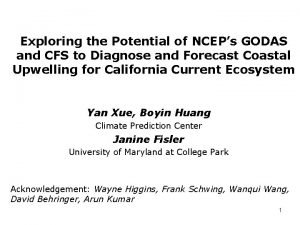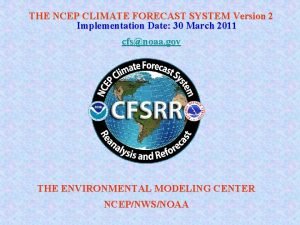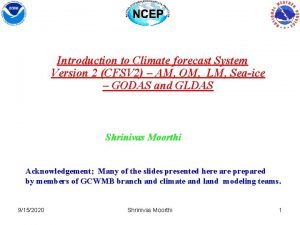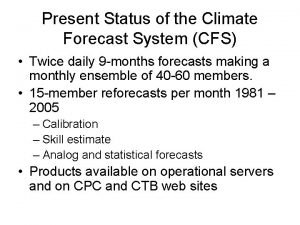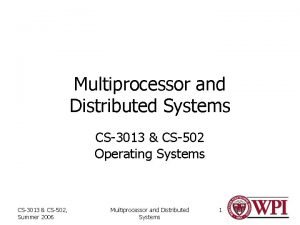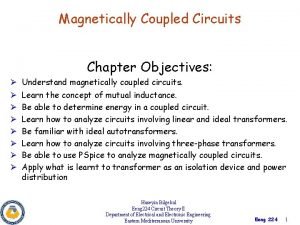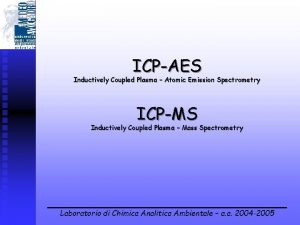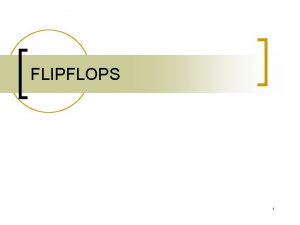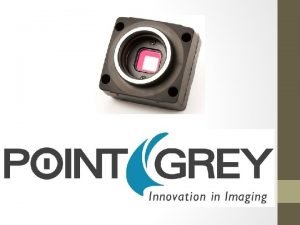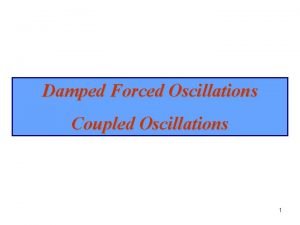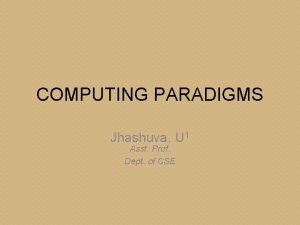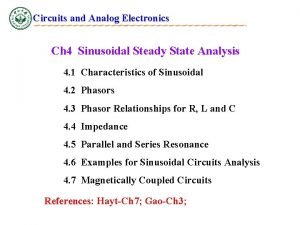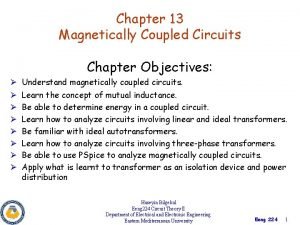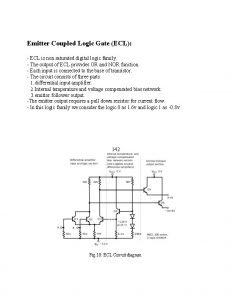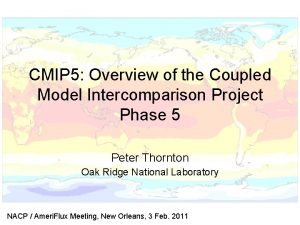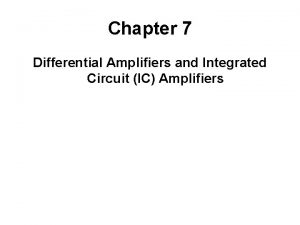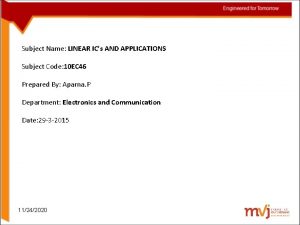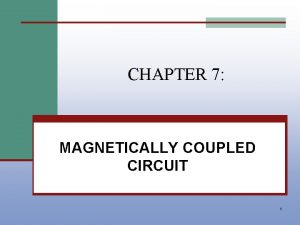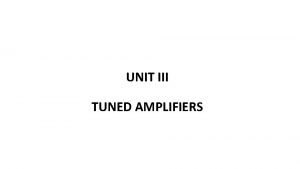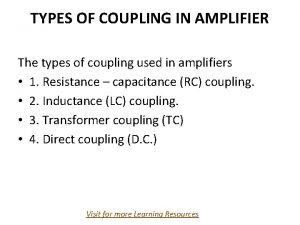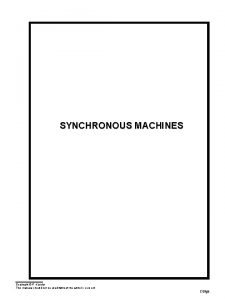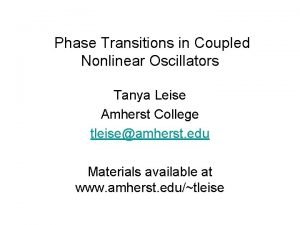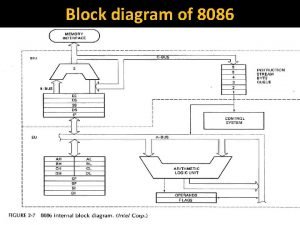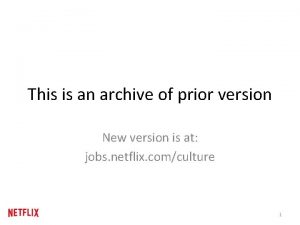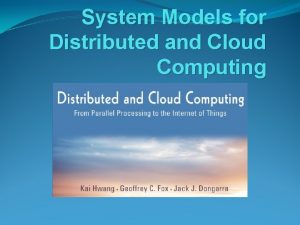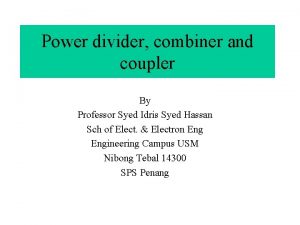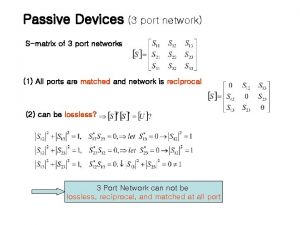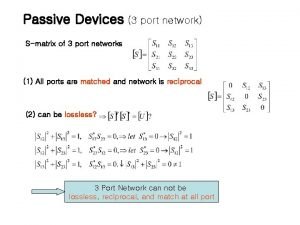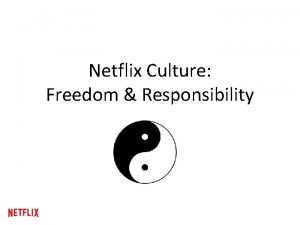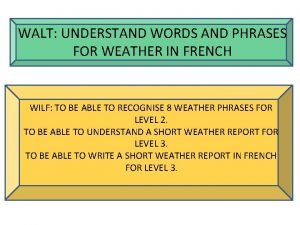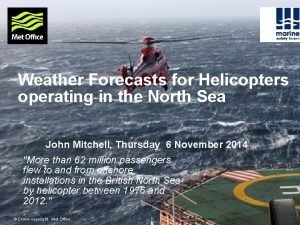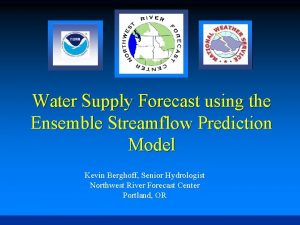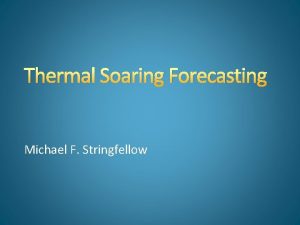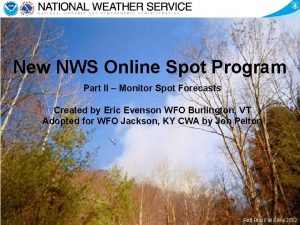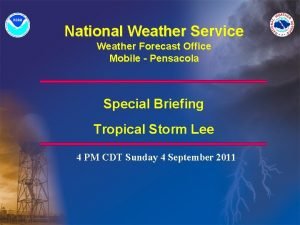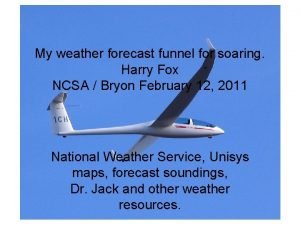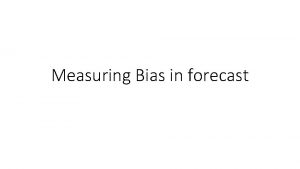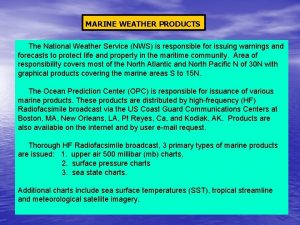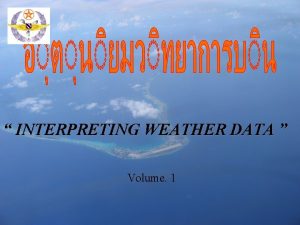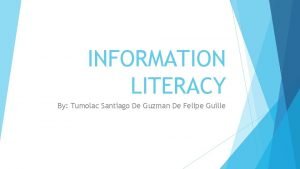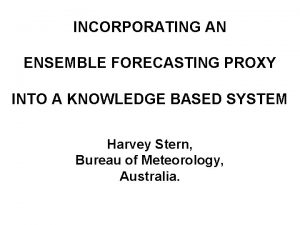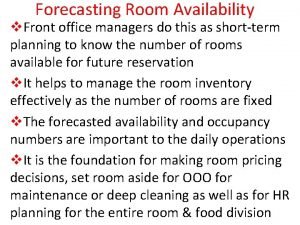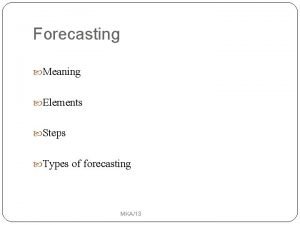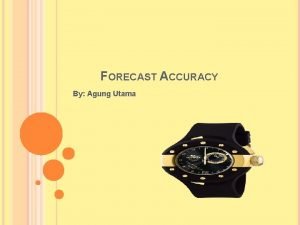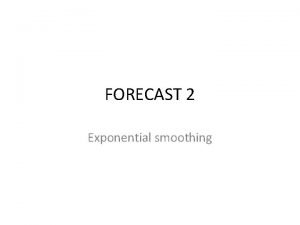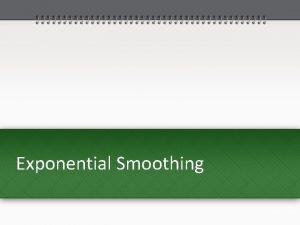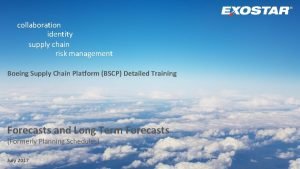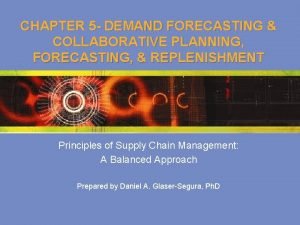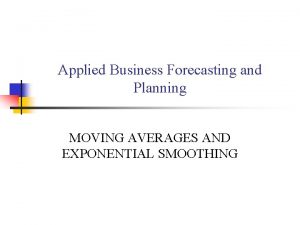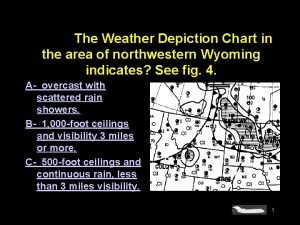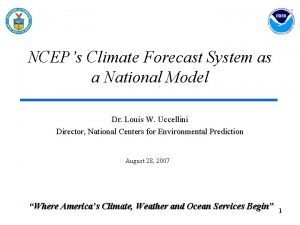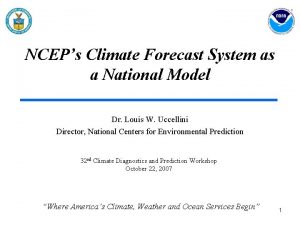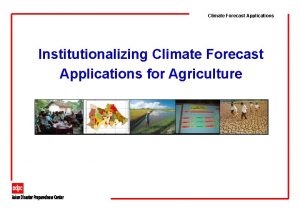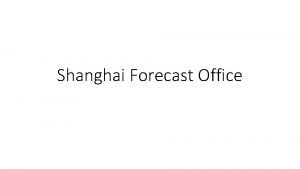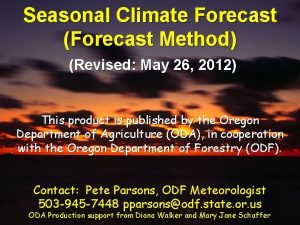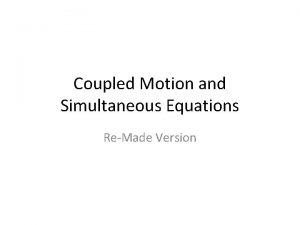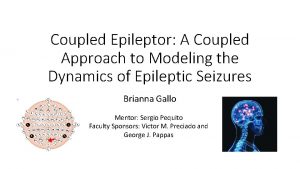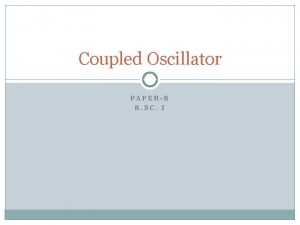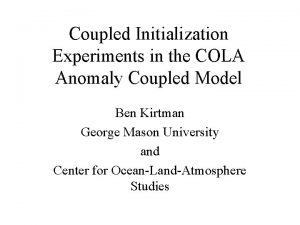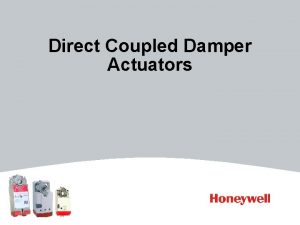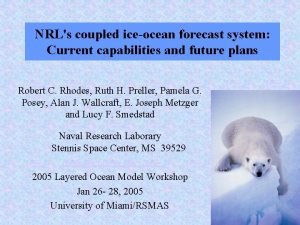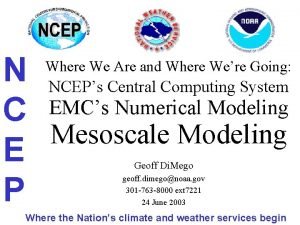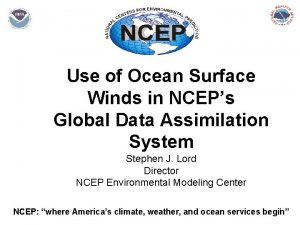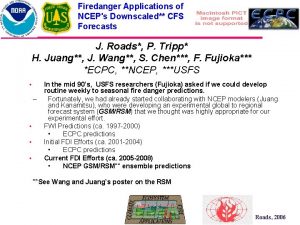Development and Testing of NCEPs Coupled Climate Forecast



![NCEP Seasonal Forecast System Prior to August 2004 (Cont) • Coupled model provides [ensemble] NCEP Seasonal Forecast System Prior to August 2004 (Cont) • Coupled model provides [ensemble]](https://slidetodoc.com/presentation_image_h2/34af27d7681196b0197d274aaf48750d/image-4.jpg)










































































- Slides: 78

Development and Testing of NCEP's Coupled Climate Forecast System Stephen Lord (EMC/NCEP) Presented by Huug van den Dool (CPC/NCEP) S. Saha, S. Nadiga, C. Thiaw, J. Wang, W. Wang, Q. Zhang 1

Overview • Introduction • Development of CFS – Simulation – Reforecast results • Prediction of extreme events • Possible projects 2

NCEP Seasonal Forecast System Prior to August 2004 • Developed 1995 -2001 • Atmospheric Seasonal Forecast Model (SFM) – First NOAA operational seasonal forecast model • Ocean model and data assimilation – Equatorial Pacific domain – Provides 4 initial weekly ocean states – TOGA/TAO, XBT, ship, altimeter data 3
![NCEP Seasonal Forecast System Prior to August 2004 Cont Coupled model provides ensemble NCEP Seasonal Forecast System Prior to August 2004 (Cont) • Coupled model provides [ensemble]](https://slidetodoc.com/presentation_image_h2/34af27d7681196b0197d274aaf48750d/image-4.jpg)
NCEP Seasonal Forecast System Prior to August 2004 (Cont) • Coupled model provides [ensemble] SST forecasts – 1995 NCEP atmospheric model – MOM V. 1 Pacific Ocean model – Anomaly flux coupling – SFM ensemble runs from SST ensemble realizations 4

NCEP’s NEW CFS Components for S/I Climate • T 62/64 -layer version of the current NCEP atmospheric GFS (Global Forecast System) model – – – Model top 0. 2 mb Simplified Arakawa-Schubert convection (Pan) Non-local PBL (Pan & Hong) SW radiation (Chou, modifications by Y. Hou) Prognostic cloud water (Moorthi, Hou & Zhao) LW radiation (GFDL, AER in operational wx model) • GFDL Modular Ocean Model, version 3 (MOM-3) – 40 levels – 1 degree resolution, 1/3 degree on equator • Global Ocean Data Assimilation (GODAS) • Fully coupled atmosphere-ocean (no flux correction) 5

NCEP Global Ocean Data Assimilation System (GODAS) • Real time global ocean data base – ARGO (1000 reports/month), altimeter, XBTs, buoys, SST – Community access to ocean data – Standardized formats with embedded QC meta data • Global ocean data assimilation system – Upgraded ocean data analysis • Reanalysis (ODASI) • Salinity analysis (improved use of altimeter observations) • Implemented September 2003 6

CFS Simulation Study • 38 year ‘free’ run • Fully coupled system (NO FLUX CORRECTION) – 64 level atmospheric model – Sensitivity result using 28 level atmospheric model • Initial conditions – GODAS – 1 January 2002 • Verification – Observed Fields : NCEP/NCAR Reanalysis/CDAS 7

CFS Simulations 64 Level (0. 2 h. Pa) vs 28 Level (2. 0 h. Pa) Atm. ENSO SST cycles Nino 3. 4 SST Anomalies Observed 28 Level Atm Coupled Red: monthly bias 64 Level Atm 8

Coupled Model Simulation SST Interannual Variability Observed 28 Level Atm 64 Level Atm 9

Coupled Model Simulation 38 Year Mean SST Bias 10

Examples of ENSO events Simulated El Nino 2015 -2016 Simulated La Nina 2017 -18 Real El Nino 1982 -1983 Real La Nina 1988 -1989 11

Tropical Precipitation Performance AC=. 86 AC=. 80 AC=. 43 12

Re-Analysis AMIP Coupled 28 Level Atm 64 Level Atm 13

CDAS Chi anomalies 1979 -1983 14

64 layer model Chi anomaly with climatological SST 15

16

200 mb Velocity Potential Anomaly AMIP runs & Opnl Verif. 17

Easterly waves in the AMIP run 18

Easterly waves in the observations 19

AMIP run: Rotated EOF (Nov-Mar) Z 200 NCEP Reanalysis AMIP NAO PNA 20

Hindcast Skill Assessment • Atmosphere • 15 -member ensemble over 25 years from 1981 -2004 • Monthly mean forecasts for all 12 months • 9 month forecasts • Initial states 0000 GMT + or - 2 days from ocean state for each month • Reanalysis-2 archive forces both historical and real time forecasts • Operational system continues updating model climatology • Ocean • NCEP Global Ocean Data Assimilation System (GODAS) • Initial states 0000 GMT for 1 st, 11 th, 21 st of each month • GODAS operational September 2003 21 • Global ocean state 1 week behind real time

Hindcast Skill Assessment (cont) • Hindcast skill • Estimated after doing a bias correction for each year • Uses model climatology based on the other years • Anomaly correlation skill score • Nino 3. 4 region SST prediction • Standard atmospheric variables such as temperature, precipitation • Skill maps • Anomaly of model vs its own climatology in coupled mode • Comparisons with CMP 14 (former operational system) and CASST (CPC statistical technique) 22

Ensemble Mean CASST CMP 14 April IC 23

Observed 6 Month Lead (November) from April IC SST anomaly for 1981 -2002 Note Amplitudes 24

CASST January IC Ensemble Mean CMP 14 25

Observed 6 Month Lead (August) from January IC SST anomaly for 1981 -2002 Note Amplitudes 26

Hindcast Monthly Averaged SST Anomaly Correlation April IC June-September Left: New Coupled System Right: CMP 14 27

Hindcast Seasonally Averaged SST Anomaly Correlation January IC Left: New Coupled System Right: CMP 14 28

29

1 st and 2 nd modes of REOF for SST 30

CFS U. S. Surface Temperature Hindcast Skill (left) 3 Month Averages April IC Comparison with CPC CCA Method (right) Note: Coupled System skill Has different geographical Distribution than CCA 31

CFS U. S. Surface Temperature Hindcast Skill (left) 3 Month Averages January IC Comparison with CPC CCA Method (right) Note: Coupled System skill Has different geographical Distribution than CCA 32

CFS U. S. Precipitation Hindcast Skill (left) 3 Month Averages April IC Comparison with CPC CCA Method (right) Note: Coupled System skill complementary to CCA 33

CFS U. S. Precipitation Hindcast Skill (left) 3 Month Averages January IC Comparison with CPC CCA Method (right) Note: Coupled System skill complementary to CCA 34

Seasonal Forecast for Tropical Vertical Wind Shear (Chelliah & Saha) 35

Performance of the NCEP CFS Forecasts for Severe Weather Events Suranjana Saha Environmental Modeling Center NCEP/NWS/NOAA/DOC 36

CFS Performance for Extreme Events • What is an extreme? Large departure from normal, for example in temperature and/or precipitation, we have heat waves, cold spells, droughts, floods, etc. • Given how important the effect of extremes is on society (life, property and the economy), did the CFS predict these events ? 37

CFS Performance for Extreme Events (cont) • We evaluate skill in CFS predictions only on occasions when an extreme occurred in observations. • “Probability of detection” • Using monthly mean data, we define an extreme = |value| of anomaly of variable >= 2 or 1. 5 times local standard deviation. 38

CFS Performance for Extreme Events • Two initial cases – Mississippi flood of 1993 – Midwest drought of 1988 – Lead times of 1 -5 months • Time series of extreme events over the U S Midwest – 1 month lead time 39

CFS Performance for Extreme Events (cont) 1993 Flood 1988 Drought 40

EXTREME EVENTS IN TEMPERATURE (Reanalysis-2 used for validation) 41

One Month Lead NW SW NE SE 42

Lead Time vs Season 43

44

45

46

47

48

49

50

51

Conclusions (for Temperature) 1. US : Modest skill mainly in late spring 2. Europe : No skill 3. India : Modest skill mainly in winter 4. Africa : Modest skill mainly Northern winter 5. South America: Moderate skill throughout the year. 52

EXTREME EVENTS IN PRECIPITATION (Xie-Arkin Precip used for validation) 53

NW NE SW SE 54

U. S. Forecasts of Extreme Precipitation Events 55

56

57

58

59

60

61

62

Conclusions (for Precipitation) 1. US : Modest skill mainly in winter 2. Europe : No skill at all 3. India : Modest skill mainly Feb-May 4. Africa : Modest skill mainly Aug-Jan 5. South America: Modest skill throughout the year only for lead-1. 6. (Keep in mind there are complications when precipitation is 63 skewed, or standard deviation is small (like deserts).

Conclusions and Possible Collaborations • The NCEP CFS displays realistic behavior for monthly and seasonal forecasts • An accompanying reforecast data set – Is used operationally to define forecast skill – Can be used in research mode for a wealth of climate studies of predictability • Suggestions for future work – Extending predictability work of Saha – Continued evaluation and understanding of more detailed system performance • Tropical, topographic interactions, AO…. – Development, assembly and testing of next CFS 64

Conclusions and Possible Collaborations (cont) • Study the impacts of : – – – – vertical resolution. 28, 42 and 64 levels convection in different vertical resolutions running RAS pbl impact by running with an older version of the PBL prognostic cloud scheme versus diagnostic cloud scheme. Impact of sub-grid scale orography with different mountain variance Impact of new longwave and shortwave radiation in the CFS Impact of new ice model for polar regions Stratus deficiency Testing Noah 3. 0, GLDAS, NLDAS for Climate applications, including application to Drought Monitor Mitigate ocean model biases and develop advanced ODA techniques and investigate impact of MOM-4 Test sigma-p and sigma-theta hybrid coordinates Sensitivity experiments for tuning the ocean mixed layer Investigation of simulated ocean - atmosphere modes of variability at the subseasonal timescale and assessment of their realism at different lead times; improvement of relevant parameterizations. Estimation of the realism of simulated scale interactions (subseasonal to seasonal time scales) 65 Modification of physics to enhance PNA, AO, MJO, NAO, AAO indices

Conclusions and Possible Collaborations (cont) • 5 -45 day forecast project – Output from 45 day runs has been saved twice-daily data from the entire CFS hindcast set from 1981 -present, nearly 24 years. – 15 members per month – Selected subset for 1997 -2004 • Evaluation of subseasonal skill for Regional Climate Model experiments • 15 additional members/month (1/day) • 6 hourly output • Possible new monthly product • Requires GODAS (data assimilation) run in real time instead of the current 7 -day lag • Enhanced ensemble size • Hindcasts will still have to be done to provide calibration 66

Questions and Discussion 67

The latest forecast 68

Ocean Data Assimilation - Impact of Salinity 69

Examples of ENSO events Subsurface Temperature Anomalies At the Equator Observed (GODAS) Depth Pacific Ocean Simulated Time Pacific 70 Ocean

71

72

73

Priority • • • Cloud-radiation interaction Orographic forcing Mesoscale forecast Hurricane forecast Seasonal forecast Week-2 and monthly forecast 74

The Weather Point of view • We decide on the physics upgrade based on model performances in the synoptic forecasts. We try to get the most realistic forecasts of mid-latitude as well as tropical systems in the 0 -14 day time range • We evaluate the forecasts both on the correlations with analysis but also with observations 75

Our current activities • Orography – Separation of grid resolvable part and sub-grid part – Improvement of the sub-grid block effect • Cloud – Testing of Ferrier cloud scheme – Merging of RAS and SAS 76

Other activities • PBL – Song-You Hong’s new YSU pbl scheme • Radiation – AER shortwave scheme • Working with meso group to test GFS physics at high resolutions 77

Low hanging fruits • Shallow convection • Cloud fraction 78
 Nceps
Nceps Climate forecast system version 2
Climate forecast system version 2 Cfsv
Cfsv Cfs climate forecast system
Cfs climate forecast system Climate change 2014 mitigation of climate change
Climate change 2014 mitigation of climate change Claims of value examples
Claims of value examples Positive negative testing
Positive negative testing Static testing and dynamic testing
Static testing and dynamic testing Tightly coupled multiprocessor
Tightly coupled multiprocessor Coupled transport example
Coupled transport example Magnetic coupled circuit
Magnetic coupled circuit Inductively coupled plasma
Inductively coupled plasma Cross coupled nor gates
Cross coupled nor gates Multistage amplifier
Multistage amplifier Charge coupled device
Charge coupled device Coupled pendulum
Coupled pendulum All resources are tightly coupled in computing paradigm of
All resources are tightly coupled in computing paradigm of Complex impedances
Complex impedances Rt ln q
Rt ln q Coupled circuits
Coupled circuits Coupled reaction
Coupled reaction Ecl emitter coupled logic
Ecl emitter coupled logic Coupled model intercomparison project phase 5
Coupled model intercomparison project phase 5 Emitter coupled differential amplifier
Emitter coupled differential amplifier Capacitor coupled non inverting amplifier
Capacitor coupled non inverting amplifier Magnetically coupled circuits lecture notes
Magnetically coupled circuits lecture notes Charge coupled device detector
Charge coupled device detector Difference between single tuned and double tuned amplifier
Difference between single tuned and double tuned amplifier Different types of coupling in amplifiers
Different types of coupling in amplifiers Synchronous motor equations
Synchronous motor equations Tanya leise amherst
Tanya leise amherst Block diagram of loosely coupled configuration
Block diagram of loosely coupled configuration Highly aligned loosely coupled meaning
Highly aligned loosely coupled meaning Distributed system models in cloud computing
Distributed system models in cloud computing Coupled line coupler
Coupled line coupler 3 port network
3 port network 3 port network
3 port network Netflix context not control
Netflix context not control Domain testing example
Domain testing example Logic based testing in software testing
Logic based testing in software testing Du path testing
Du path testing Localization globalization testing
Localization globalization testing Neighborhood integration testing
Neighborhood integration testing Language testing
Language testing Control structure testing in software testing
Control structure testing in software testing Decision table testing in software testing
Decision table testing in software testing Decision table based testing
Decision table based testing Apa itu black box testing
Apa itu black box testing Behavior testing adalah
Behavior testing adalah Decision table testing is white box
Decision table testing is white box Rigorous testing in software testing
Rigorous testing in software testing Testing blindness in software testing
Testing blindness in software testing Component testing is a black box testing
Component testing is a black box testing Domain testing in software testing
Domain testing in software testing French weather phrases
French weather phrases Helicopter weather forecast
Helicopter weather forecast Nwrfc water supply
Nwrfc water supply Dr jack rasp
Dr jack rasp Probabilistic snow forecast
Probabilistic snow forecast Spot nws
Spot nws Pensacola wind forecast
Pensacola wind forecast Dr jack soaring
Dr jack soaring Forecast bias calculation
Forecast bias calculation Marine forecast pensacola
Marine forecast pensacola Rumus metode semi average
Rumus metode semi average Metar vtbd
Metar vtbd Disaster scenario according to the weather forecast
Disaster scenario according to the weather forecast Terminal aerodrome forecast
Terminal aerodrome forecast Forecasting room availability in front office
Forecasting room availability in front office Forecast horizon
Forecast horizon Agung utama
Agung utama Exponential smoothing model
Exponential smoothing model Exponential smoothing forecast formula
Exponential smoothing forecast formula Forecast collaboration feature
Forecast collaboration feature The goal of cpfr is to
The goal of cpfr is to Simple exponential smoothing forecast
Simple exponential smoothing forecast Lesson outline lesson 3 answer key
Lesson outline lesson 3 answer key Weather depiction
Weather depiction Peramalan keuangan
Peramalan keuangan
